People
Get a Closer Look at Lagos-Based Artist Nengi Omuku’s Intricate Textile Paintings—Made on Traditional Nigerian Cloth
Kasmin gallery recently announced their representation of Omuku in New York.
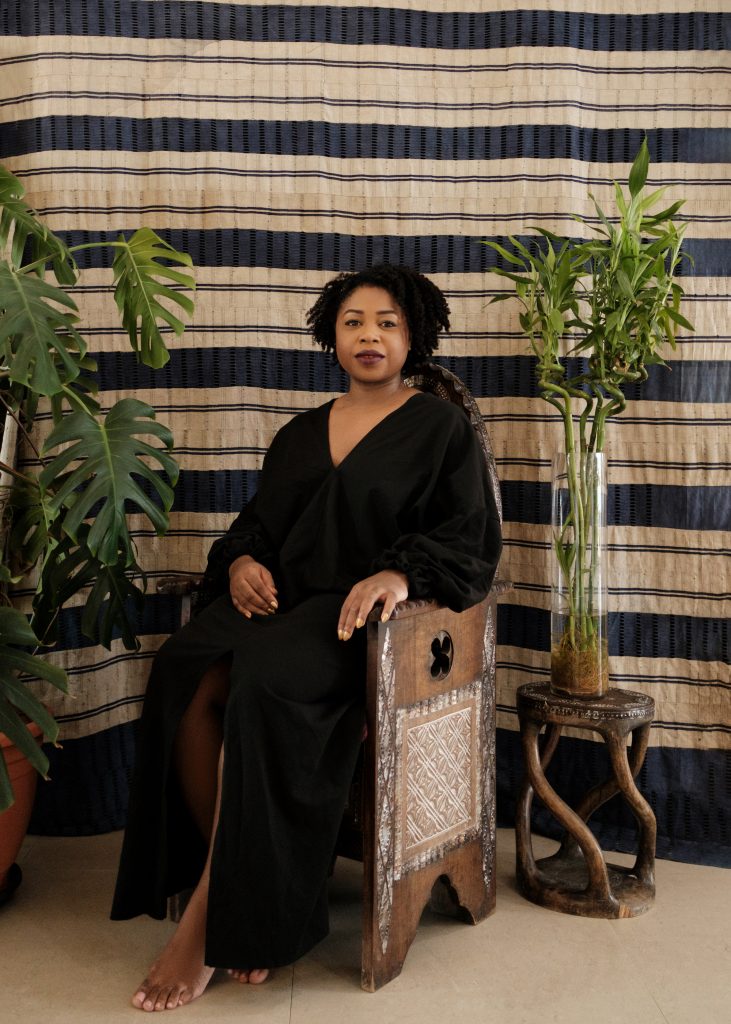
Kasmin gallery recently announced their representation of Omuku in New York.

Annikka Olsen

The contemporary art world has seen an uptick in artists working with both textiles and with Indigenous craft traditions, but the two strands weave together in the work of Nengi Omuku, whose paintings on fabric have a distinct sculptural effect. Having exhibited her work internationally, with shows in Nigeria as well as the United States and Europe, the artist recently joined Kasmin gallery of New York (and is jointly represented by Pippy Houldsworth Gallery and Kristin Hjellegjerde Gallery in London). A solo show of her work is slated for Kasmin next year. Omuku stands out not only for her ethereal, sometimes dreamlike paintings, but also for what she paints on: traditional sanyan cloth.
Sanyan, one of the elemental types of aso oke, a woven Yoruba textile, has a long and storied history and cultural significance in Nigeria, where Omuku was born and lives today. Trained as a painter, the artist completed her B.A. and M.A. at the Slade School of Fine Art in London, but upon her return to her home began an investigation into textiles. Part of the impetus for this investigation is the fact that the decorative fabric commonly understood as “African” is actually Dutch Wax print, a mechanically printed cotton textile that originated in the Netherlands—which led Omuku to the question, what textile instead is originally African?
Early projects saw the artist creating paintings of textiles from different Nigerian states, along the way engaging with people from older generations and asking them what they considered indigenous, “trying to dig back as far as possible,” she said. During the course of these endeavors, someone showed Omuku their collection of sanyan clothes. “It was a lightbulb moment,” she said. In the sanyan, Omuku saw the qualities of Nigerian culture and ideas around indigeneity that she had been pursuing synthesized, and it provided an opportunity for her to materially fold the inherent significance of the traditional fabric into her practice.
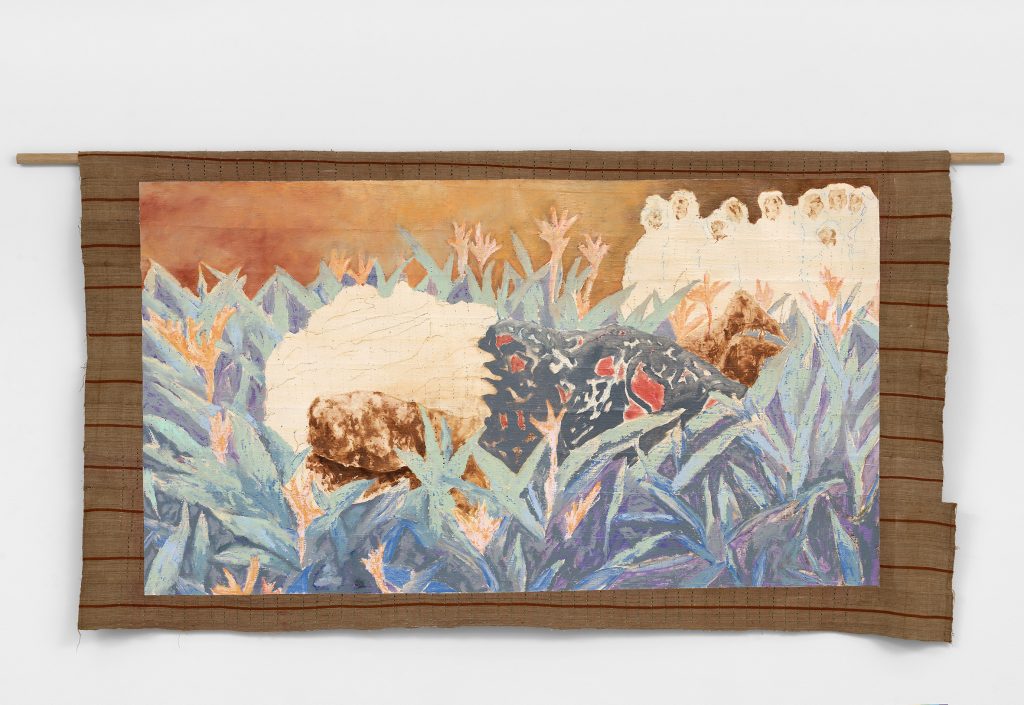
Nengi Omuku, Welcome home (2022). © Nengi Omuku. Courtesy of Kasmin & Pippy Houldsworth Gallery.
Commonly used in the making of garments for special occasions, such as weddings, the fabric she sourced early on came from markets, which she would scour for complete dress sets (comprised of a skirt-like wrapper, sash, and head tie) made from sanyan. From here, Omuku transformed the garments into flat cloth by meticulously deconstructing and reversing the stitching of the various item’s panels, rearranging them so that the embroidered, dyed, or other designed features all faced outwards, creating a type of tapestry. In an act of respect and reverence for the materials and the fabric’s maker, Omuku paints on the reverse side so as to conserve the artistry, including preserving the prayers woven into the pattern through the use of symbolic motifs.
This turn in Omuku’s practice of painting on sanyan, which has a hallmark khaki-beige base color, also influenced the way she painted. Where previously her palette was very vibrant and bright, “working with the textile,” she explained, “my palette just gradually started changing to these muted tones. I still used quite a lot of color, just dulled down quite a bit.” In each of Omuku’s works, there is a reciprocity and dialogue between the fabric and her painted compositions. “It’s not something I have to think of consciously anymore, but if the sanyan has yellow stripes, I find I start using a lot of yellow in my palette, because I want it to be a harmonious experience when it’s done.”
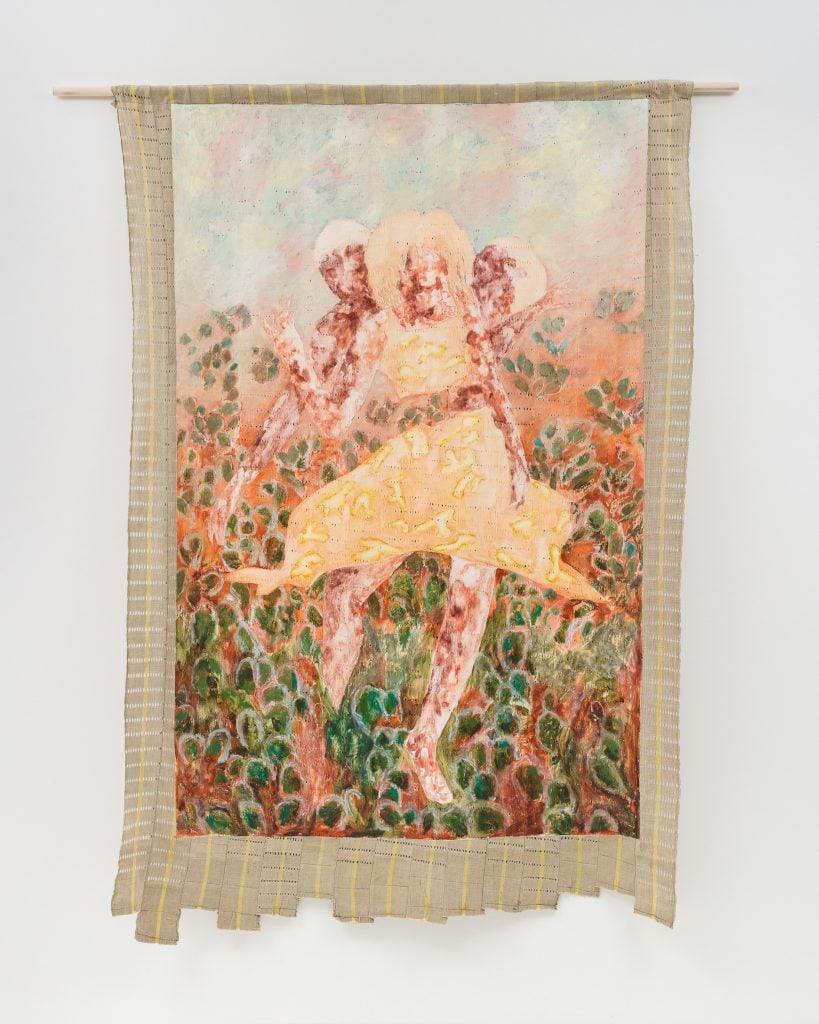
Nengi Omuku, Swing (2022). © Nengi Omuku. Courtesy of Kasmin and Pippy Houldsworth Gallery.
Composed in oil paint on a gesso-prepared stretch of composited sanyan, though Omuku’s style is decidedly contemporary it is Impressionistic at heart. She makes no attempt to hide or obscure the brushstrokes or create even fields of color, instead relying on an overall harmony of color and shape to reveal the image. And the image chosen is born out of a process of both creative intuition and calculated composition, as the artist begins her work variously from a life model, a photo, or a subject drawn from her imagination. From here, “the next step for me is always collage,” Omuku said. “If I’m working with a sitter, I draw it out, but then I assemble collaged elements that I want to create the entire space. From there, it gives me a rough idea of where the painting will go—but where it goes can change quite dramatically.”
Her sources of inspiration are varied and intuitive, drawing from art history, her imagination, life experiences, and, perhaps most commonly, nature. The artist’s mother is a florist and horticulturist who instilled a love of the natural world. Although she initially resisted focusing on landscapes and plant life, since working in “psychological spaces” is the mark of contemporary painting, ultimately, Omuku mused, “artists have always been inspired by gardens and nature, and that’s OK.” Often landscape serves as the “protagonist” of her paintings, with the figuration blending seamlessly into the ground of the vignette, rather than foregrounded or animated with narrative elements.
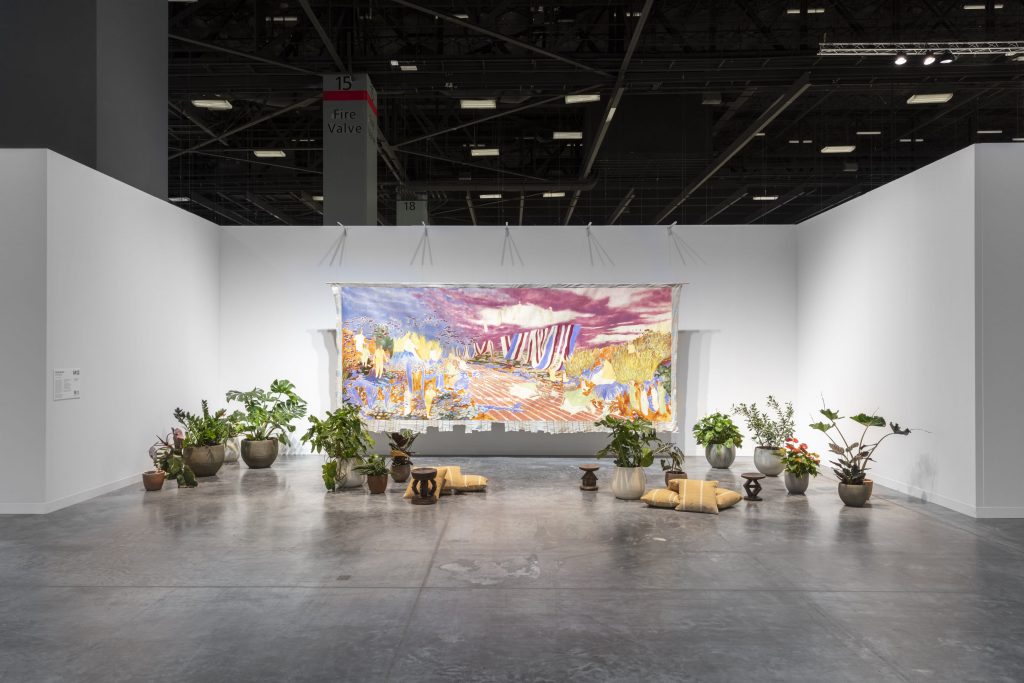
Installation view of Nengi Omuku, Eden (2022) at Art Basel Miami Beach’s “Meridians” (2022). © Nengi Omuku. Courtesy of Kasmin and Pippy Houldsworth Gallery.
Omuku’s largest piece to date, Eden (2022), was featured at Art Basel large-scale “Meridians” presentation in Miami Beach last year. To create the support, the artist had to utilize between three and four complete sanyan sets—each of which had elements of blue embroidery that, as with her smaller scale works, had to be disassembled, rearranged, and hand-stitched into one continuous ground for her painting. The composition features an amalgamation of elements drawn from the artist’s imagination, and collaged together.
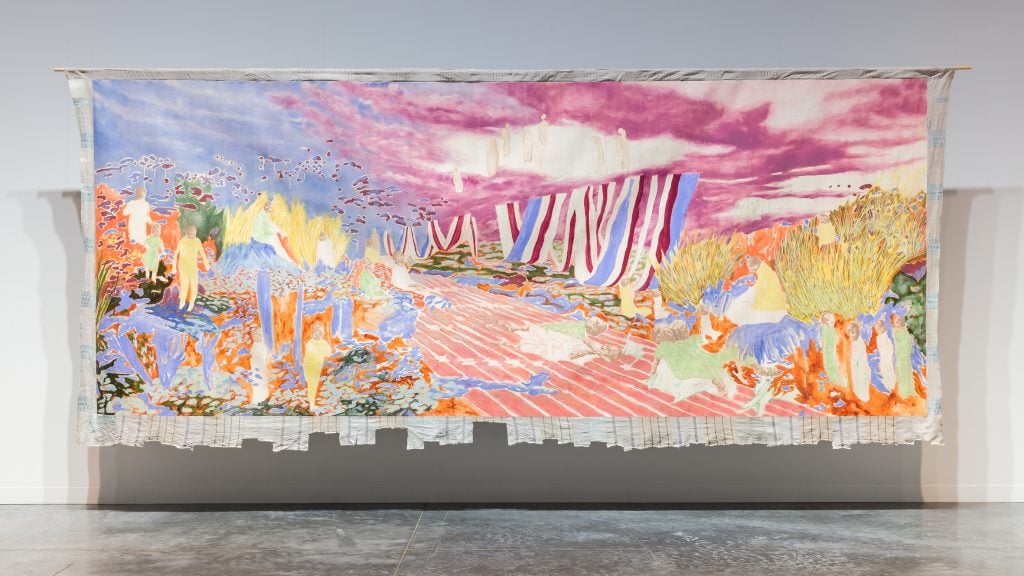
Nengi Omuku, Eden (2022). © Nengi Omuku. Courtesy of Kasmin and Pippy Houldsworth Gallery.
Late last year, Omuku completed a residency at Black Rock Senegal, founded by Kehinde Wiley, which served as a catalyst for what would be a major transformation of her process. While there, she learned about the continued practice of spinning cotton in Senegal, and was able to meet with artist Fatim Soumaré, who has spearheaded the revival of the practice. Employing over 200 women spinners from different villages, the craft of cotton spinning has been revitalized, and Omuku learned how to process the raw material—even trying her hand at spinning “from cloud to thread.”
Though sanyan originally was made from silk or a silk blend, recent production of the fabric often uses only cotton. Learning about the techniques and methods used to make it offered a deeper understanding of the material. After she returned to Nigeria, she renewed her interest in investigating the textile.
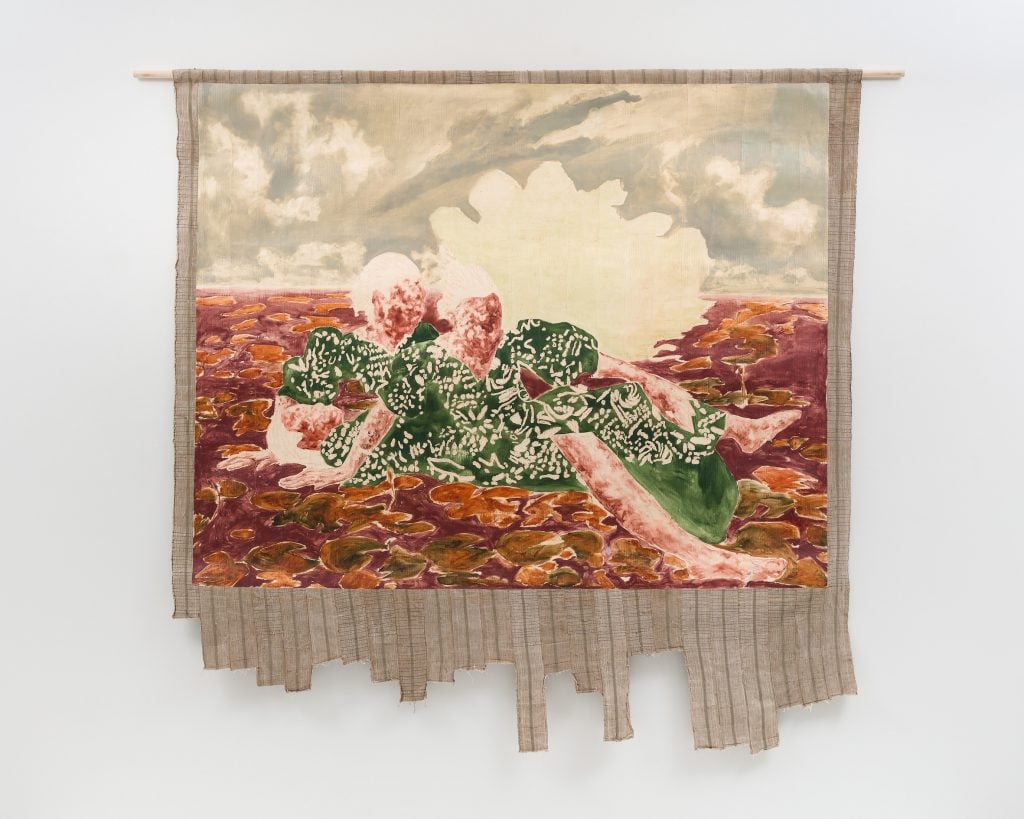
Nengi Omuku, Repose (2022). © Nengi Omuku. Courtesy of Kasmin and Pippy Houldsworth Gallery.
Though once a major industry in Nigeria, recently cotton spinning has all but died out. Nevertheless, with the help of her studio team and artist friends, Omuku investigated who and where it might still be made. What they found was a family of cotton spinners about four hours outside of Lagos. The opportunity to work with a local producer adds another layer of connection between her work and the craft’s continuing history. Omuku now commissions the family to make sanyan specifically for the purpose of painting, which includes receiving it unstitched. By obtaining the material at specification, Omuku is unconstrained by size, and the material may be constructed to whatever dimensions she prefers to work at—though she does still sometimes paint on repurposed vintage sanyan sets.
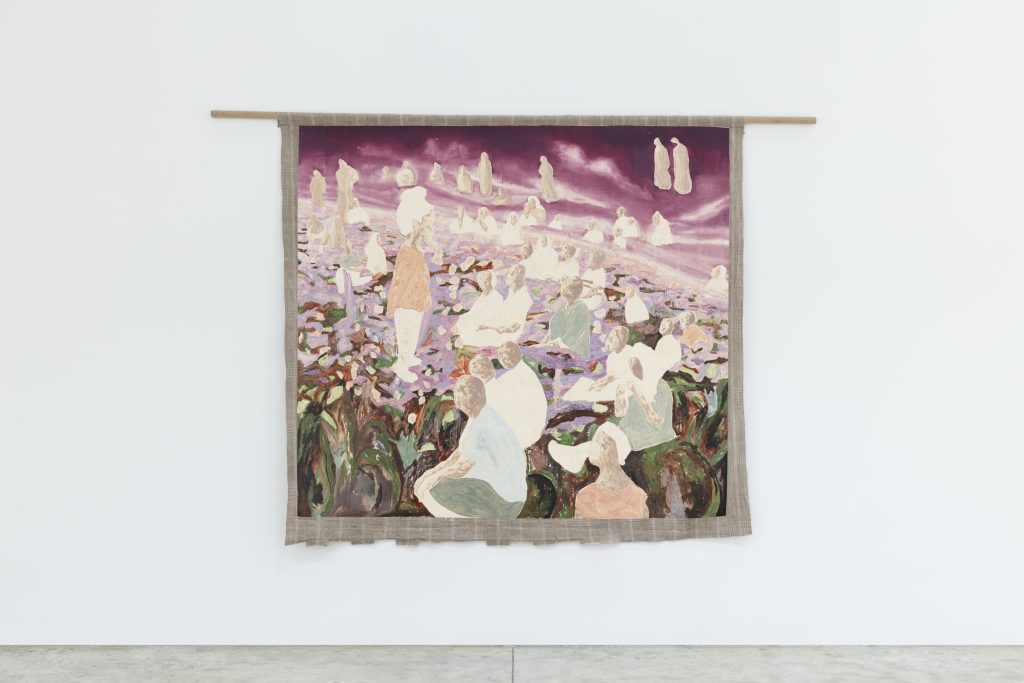
Nengi Omuku, The Lighthouse (2021). Nengi Omuku, Repose (2022). © Nengi Omuku. Courtesy of Kasmin and Kristin Hjellejerdge Gallery
Omuku’s artistic line of inquiry is a tailor-made fit for her inclusion in the St. Louis Art Museum (SLAM) exhibition “Aso Oke: Prestige Cloth from Nigeria,” currently on view through March 10, 2024. While planning the show, which highlights the textiles of Yoruba weavers, curators wanted to incorporate the work of a contemporary artist whose practice centered on the traditional textiles; the work on view is drawn from a film still from her time spent in Dakar while participating in Black Rock Senegal, at a moment where she was learning to spin cotton. Omuku is also the subject of a solo museum exhibition of ten paintings, “The Dance of People and the Natural World,” at Hastings Contemporary in East Sussex, U.K., opening October 7.
“Part of the reason I moved to Nigeria was because I felt like European art history was very heavy on me, and there was something missing—it was the soul of my practice; home was missing,” she said. “I’ve re-immersed myself here in Lagos. I’ve become more balanced in my practice.”